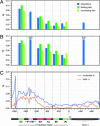Evolutionary analysis of the well characterized endo16 promoter reveals substantial variation within functional sites
- PMID: 15937122
- PMCID: PMC1150811
- DOI: 10.1073/pnas.0409638102
Evolutionary analysis of the well characterized endo16 promoter reveals substantial variation within functional sites
Abstract
The evolutionary mechanisms that operate on genetic variation within transcriptional regulatory sequences are not well understood. We present here an evolutionary analysis of an exceptionally well characterized cis-regulatory region, the endo16 promoter of the purple sea urchin. Segregating variation reveals striking differences in the intensity of negative selection among regulatory modules, reflecting their distinct functional roles. Surprisingly, transcription-factor-binding sites are as polymorphic and as likely to contain fixed differences as flanking nucleotides. Whereas nucleotides in protein-binding sites in the most proximal regulatory module exhibit reduced variation, those in other modules tend to be more polymorphic than putatively nonfunctional nucleotides. Two unrelated large insertions at the same position within the promoter are segregating at low frequencies; one is a strong ectodermal repressor that contains 16 verified transcription-factor-binding sites. These results demonstrate that a simple relationship between conservation and function does not exist within this cis-regulatory region and highlight significant population heterogeneity in the fine structure of a well understood promoter.
Figures



Similar articles
-
Conservation of Endo16 expression in sea urchins despite evolutionary divergence in both cis and trans-acting components of transcriptional regulation.Development. 2003 Sep;130(17):4187-99. doi: 10.1242/dev.00611. Development. 2003. PMID: 12874137
-
Population genetics of cis-regulatory sequences that operate during embryonic development in the sea urchin Strongylocentrotus purpuratus.Evol Dev. 2012 Mar-Apr;14(2):152-67. doi: 10.1111/j.1525-142X.2012.00532.x. Evol Dev. 2012. PMID: 23017024
-
Evolutionary analysis of the cis-regulatory region of the spicule matrix gene SM50 in strongylocentrotid sea urchins.Dev Biol. 2008 Mar 15;315(2):567-78. doi: 10.1016/j.ydbio.2008.01.007. Epub 2008 Jan 18. Dev Biol. 2008. PMID: 18262514
-
Position specific variation in the rate of evolution in transcription factor binding sites.BMC Evol Biol. 2003 Aug 28;3:19. doi: 10.1186/1471-2148-3-19. Epub 2003 Aug 28. BMC Evol Biol. 2003. PMID: 12946282 Free PMC article.
-
The evolution of transcriptional regulation in eukaryotes.Mol Biol Evol. 2003 Sep;20(9):1377-419. doi: 10.1093/molbev/msg140. Epub 2003 May 30. Mol Biol Evol. 2003. PMID: 12777501 Review.
Cited by
-
Genetic hypervariability in two distinct deuterostome telomerase reverse transcriptase genes and their early embryonic functions.Mol Biol Cell. 2009 Jan;20(1):464-80. doi: 10.1091/mbc.e08-07-0748. Epub 2008 Oct 22. Mol Biol Cell. 2009. PMID: 18946080 Free PMC article.
-
Evolutionary meandering of intermolecular interactions along the drift barrier.Proc Natl Acad Sci U S A. 2015 Jan 6;112(1):E30-8. doi: 10.1073/pnas.1421641112. Epub 2014 Dec 22. Proc Natl Acad Sci U S A. 2015. PMID: 25535374 Free PMC article.
-
Evolution of transcription factor binding in metazoans - mechanisms and functional implications.Nat Rev Genet. 2014 Apr;15(4):221-33. doi: 10.1038/nrg3481. Epub 2014 Mar 4. Nat Rev Genet. 2014. PMID: 24590227 Free PMC article. Review.
-
Mechanisms of mutational robustness in transcriptional regulation.Front Genet. 2015 Oct 27;6:322. doi: 10.3389/fgene.2015.00322. eCollection 2015. Front Genet. 2015. PMID: 26579194 Free PMC article. Review.
-
Cis-regulatory evolution of chalcone-synthase expression in the genus Arabidopsis.Genetics. 2006 Dec;174(4):2181-202. doi: 10.1534/genetics.106.064543. Epub 2006 Oct 8. Genetics. 2006. PMID: 17028316 Free PMC article.
References
-
- Carroll, S. B. (2000) Cell 101, 577-580. - PubMed
-
- Carroll, S. B., Grenier, J. K. & Weatherbee, S. D. (2004) From DNA to Diversity: Molecular Genetics and the Evolution of Animal Design (Blackwell Scientific, Malden, MA).
-
- Davidson, E. H. (2001) Genomic Regulatory Systems: Development and Evolution (Academic, San Diego).
-
- Wray, G. A., Hahn, M. W., Abouheif, E., Balhoff, J. P., Pizer, M., Rockman, M. V. & Romano, L. A. (2003) Mol. Biol. Evol. 20, 1377-1419. - PubMed
-
- Cliften, P., Sudarsanam, P., Desikan, A., Fulton, L., Fulton, B., Majors, J., Waterston, R., Cohen, B. A. & Johnston, M. (2003) Science 301, 71-76. - PubMed
Publication types
MeSH terms
Substances
Associated data
- Actions
- Actions
- Actions
- Actions
- Actions
- Actions
- Actions
- Actions
- Actions
- Actions
- Actions
- Actions
- Actions
- Actions
- Actions
- Actions
- Actions
- Actions
- Actions
- Actions
- Actions
- Actions
- Actions
- Actions
- Actions
- Actions
- Actions
- Actions
- Actions
- Actions
- Actions
- Actions
- Actions
- Actions
- Actions
- Actions
- Actions
- Actions
- Actions
- Actions
- Actions
- Actions
- Actions
- Actions
- Actions
- Actions
- Actions
- Actions
- Actions
- Actions
- Actions
- Actions
- Actions
- Actions
- Actions
- Actions
- Actions
- Actions
- Actions
- Actions
- Actions
- Actions
- Actions
- Actions
- Actions
- Actions
- Actions
- Actions
- Actions
- Actions
- Actions
- Actions
- Actions
- Actions
- Actions
- Actions
- Actions
- Actions
- Actions
- Actions
- Actions
- Actions
- Actions
- Actions
- Actions
- Actions
- Actions
- Actions
- Actions
- Actions
- Actions
- Actions
- Actions
LinkOut - more resources
Full Text Sources
Other Literature Sources
Miscellaneous

